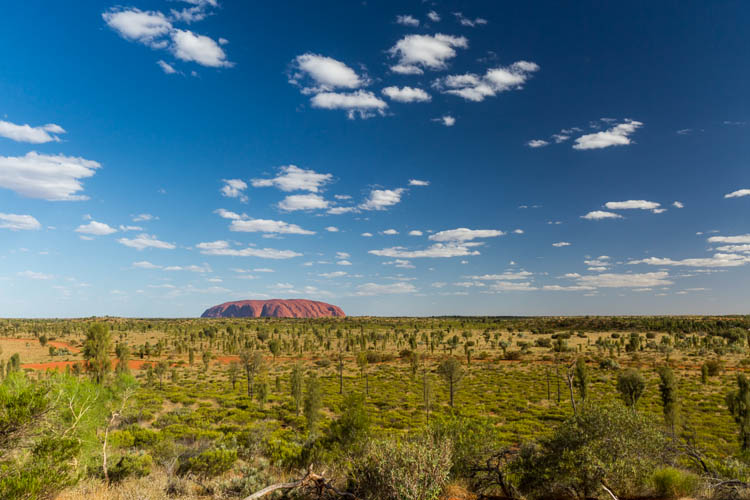
Uluru and a green-tinged central desert
Nothing conjures up images of Australia’s outback more so than Uluru (Ayers Rock). And by whatever means you arrive in the red centre, you can’t help but scan the horizon for that distinctive, ochre-coloured formation jutting out of the surrounding desert. And so it was… me staring excitedly out my airline window, looking for that iconic monolith that would tell us we’d arrived at Yulara – gateway to Uluru-Kata Tjuta National Park.
Along with a number of journalists and social media influencers, I had been invited by Voyages Ayers Rock Resort to Uluru as part of a special trip to celebrate the 25th Anniversary of the iconic Sounds of Silence dinner. “Palya!”, our hosts greeted us, in the local language of the indigenous Anangu, before whisking us to the Sails in the Desert Hotel – our luxurious outback digs for the next few days.
In an oasis of green, dotted with a brilliant blue pool and shaded by white gums, we sat down to a welcome lunch. Here we had our first introduction to Ayers Rock Resort’s bush tucker program, where we learnt about native ingredients such as bush quandong, finger lime, Davidson plum and lemon myrtle. Executive Chef Vanessa Grace went on to explain how these ancient flavours and native wildlife, including wallaby and green ants, have been infused into the resort’s modern cuisine.
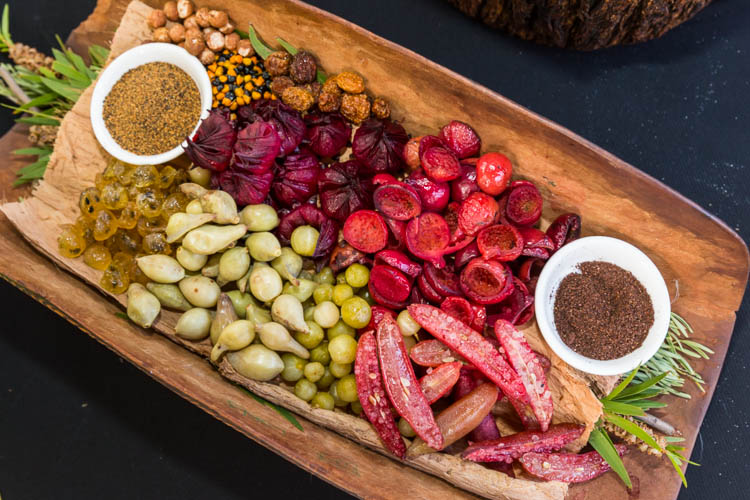
Australian ‘bush tucker’ ingredients including Davidson plum, quandong, finger lime and candied lemon aspen
After checking into my room, which was beautifully framed with natural tones and indigenous artwork, I had an opportunity for a quick jaunt into Uluru-Kata Tjuta National Park. Although this wasn’t the first time I’d visited Uluru, I was still filled with great anticipation. There’s something incredibly powerful about this scene of rock, sky and desert and it’s not hard to understand why it holds such spiritual importance to so many.
Looking out over Uluru, I was spellbound by its character: its contours; it’s pits; its shadows; it’s stained cheeks where the rains have spilled down over the millennia. From the Talinguru Nyakunytjaku lookout, we had views across a swathe of pencil-thin desert oaks to the eastern side of Uluru, now shaded in rich, brown tones. The domes of Kata Tjuta shimmered in the distance beyond. It’s a scene that sticks long in your memory.
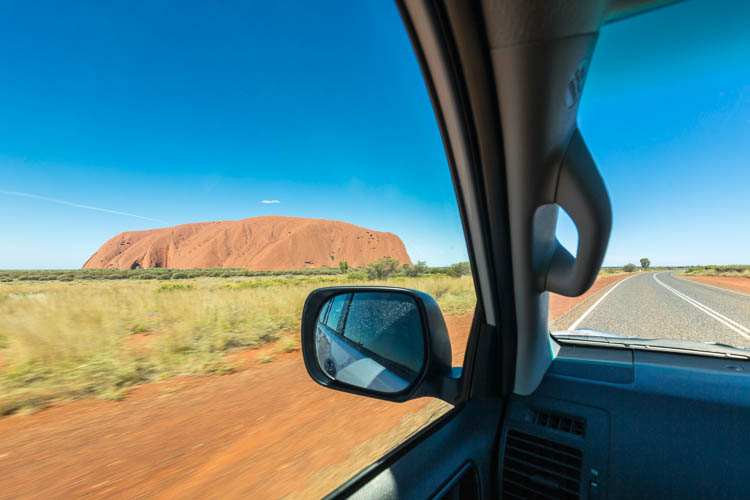
Driving through Uluru-Kata Tjuta National Park

Uluru and the domes of Kata Tjuta beyond from the Talinguru Nyakunytjaku lookout
Later that afternoon, arriving at the Sounds of Silence 25th Anniversary celebrations, we were greeted with champagne and canapés, to the sounds of the didgeridoo. As the sun slowly dipped towards the horizon, we wandered down to our table settings, stark and beautiful against the desert sands. In the background, Uluru’s colours were now transforming from orange to a deep red.
First opened in 1993, the Sounds of Silence outdoor dining experience brings together outdoor dining in the desert with the magic of an Uluru sunset and the majesty of a star-filled night sky. Soon enough, darkness descended and a roof of stars shown bright above us as we started our flavour journey with a menu rich in native indigenous ingredients. A starter of pressed kangaroo on a bed of warrigal greens and mushroom risoni was followed by a native thyme-scented lamb rack and finished with a desert lime cheesecake.
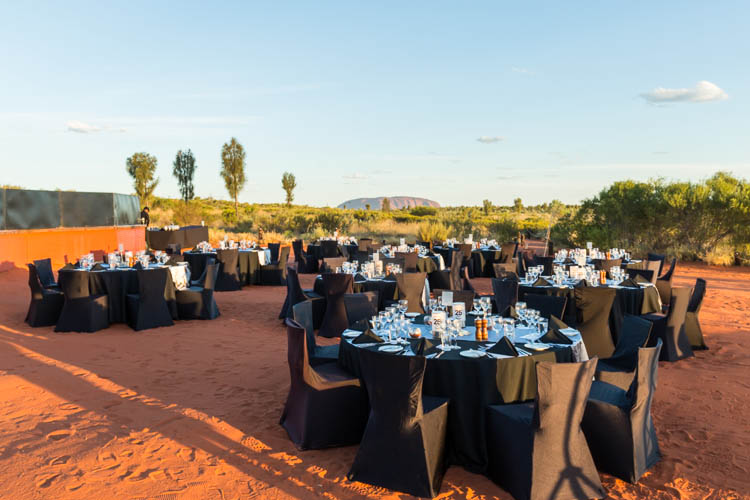
Outdoor restaurant in the desert surrounds at Sounds of Silence dining experience
During the evening we were treated to an astronomer’s tour of the southern night sky – learning about the Southern Cross and signs of the zodiac, as well as highlighting planets and galaxies visible here only due to the clarity of the night sky. Back at our desert accommodation, the night sky was still calling, as we climbed some nearby dunes to catch a glimpse of the Milky Way rising behind Uluru.

Dining under the stars at Sounds of Silence

Milky Way rising above the red centre spinifex desert
A few hours later, we were excitedly boarding a bus in the morning darkness… we were off for a pre-dawn visit to the immersive Field of Light Uluru installation. Designed by internationally celebrated artist, Bruce Munro, this amazing field of 50,000 solar-powered spheres of light, illuminates the desert floor like a mosaic carpet of glow-worms. The lights rhythmically change through a spectrum of colour, mirroring the twinkling stars of the Milky Way above. Meandering along the paths of this magic fairyland, with the twilight sky now shifting to a deep blue, I was staggered by its beauty.
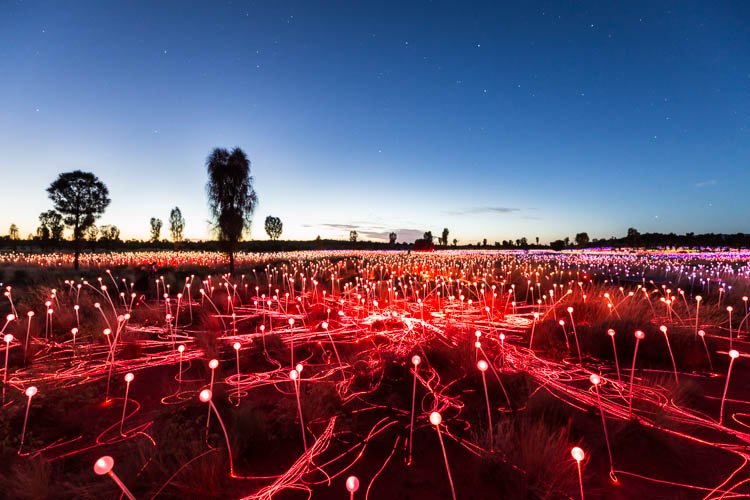
Bruce Munro’s amazing Field of Light in the central desert

Some of the installation’s 50,000 spheres of light
Ascending to the top of the dune viewing area for breakfast, we could take in the field in its entirety, with the sun’s first rays streaking across the landscape, lighting up Uluru beyond. The desert was coming to life before us – the white spheres of the installation now appearing like an endless field of enoki mushrooms in the golden light.
The next adventure was to catch a desert train: the Camel Express – for a slightly elevated perspective on the desert scenery. While I opted for a ground view of the camel action, others in the group settled in for a languid trek across the dunes, atop good-natured camels, with a backdrop of Uluru and Kata Tjuta.

The Field of Light art installation with Uluru beyond

Catching the Camel Express at Uluru
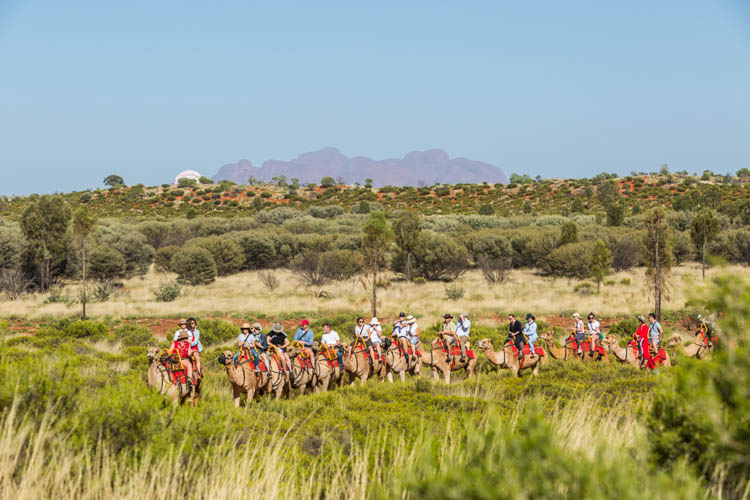
Camel trekking through the central desert with Kata Tjuta beyond
Late in the afternoon we were on the move again – the smooth bitumen around the resort giving way to rutted red tracks, taking us to a remote desert dune. Walking up to the dune-top at sunset, we were welcomed with champagne and bush tucker inspired canapés. This was Tali Wiru (meaning ‘beautiful dune’), Ayers Rock Resort’s premium, under the stars dining experience… think fine dining in an open-air restaurant with Uluru views and only the stillness of the desert night.
The menu before us promised a gastronomic odyssey, with each course paired with a wine experience – taking us around Australia’s vineyards. I was blown away with my chilled king prawns entrée and my wagyu beef fillet main. All the dishes again, featured distinctive native flavours, including a new take on the Aussie pav with camel milk gelato, passionfruit curd and green ant meringue. The brilliant night sky above us was again an astronomer’s palette as we were given an insight into the constellations and the indigenous mythology of the stars. Tali Wiru is definitely one of those bucket list dinner experiences!
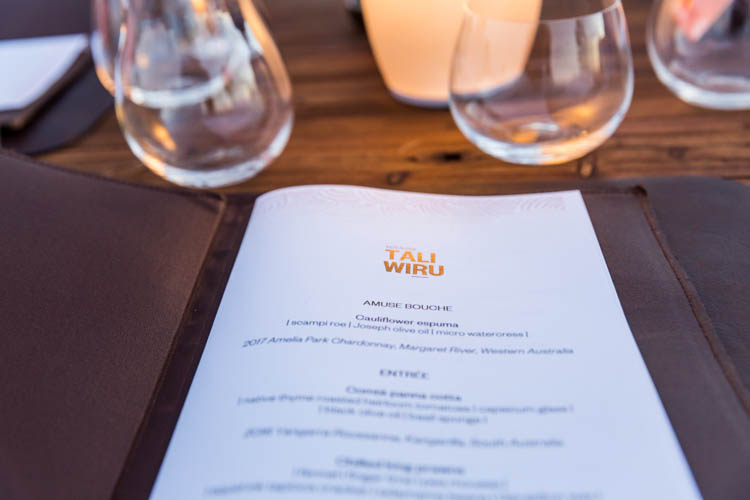
Tali Wiru dinner menu
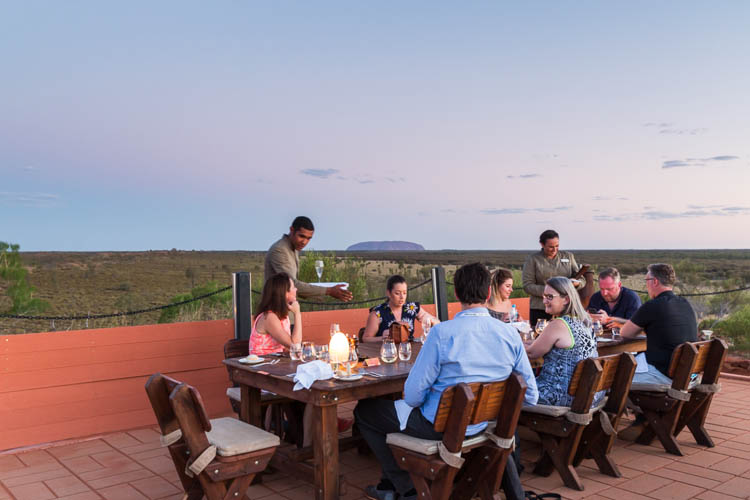
Open air restaurant dining with views to Uluru
Our last morning at Uluru and one last chance to the spy the big rock across a glowing spinifex landscape, with the resort’s ‘Desert Awakenings Tour’. From our dune top vantage point it was incredible to see how much the subtle form of Uluru dominated the landscape – it’s size only matched by the vastness of its surroundings. Driving into the National Park shortly after, we could take in it’s immensity close up.
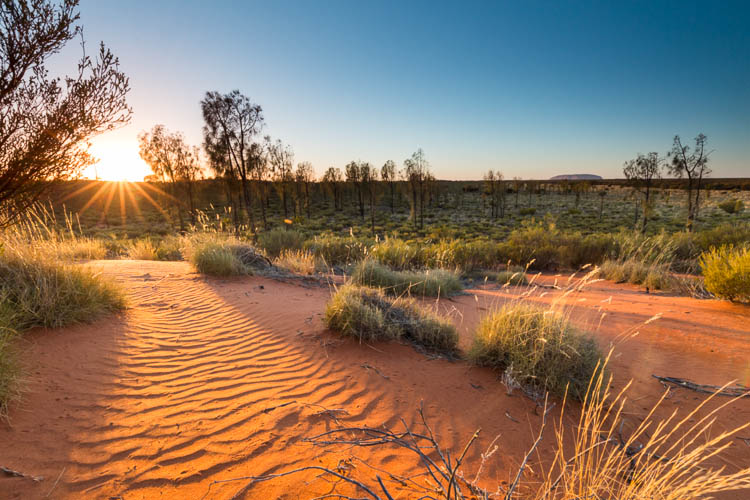
Sunrise across the desert landscape of Uluru
The walk to Mutitjulu Waterhole was across dry grasslands, which gave way to an unlikely oasis of green, with it’s trees bathed in the orange glow of the rock face towering above. The water at its base was cool and glasslike, reflecting the monolith’s rust-like façade. Our guide shared the significance of this sacred waterhole, which has provided life-giving water to plants, animals and the indigenous people of the area for thousands of years. Ancient rock paintings close to the waterhole, brought home further that connection between the land and the local Anangu people.
It’s hard not to be moved by the size and beauty of the Uluru landscape, but more-so the culture of those that have and still do inhabit the area. Uluru has a magnetic draw that will definitely see me back.
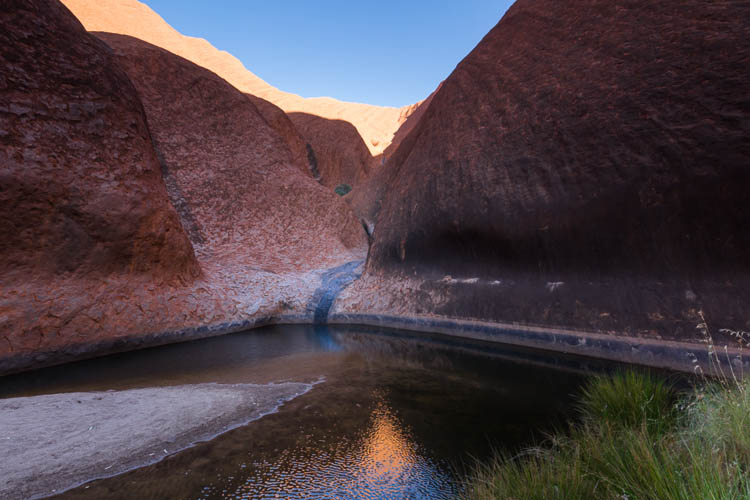
Mutitjulu Waterhole at the base of Uluru
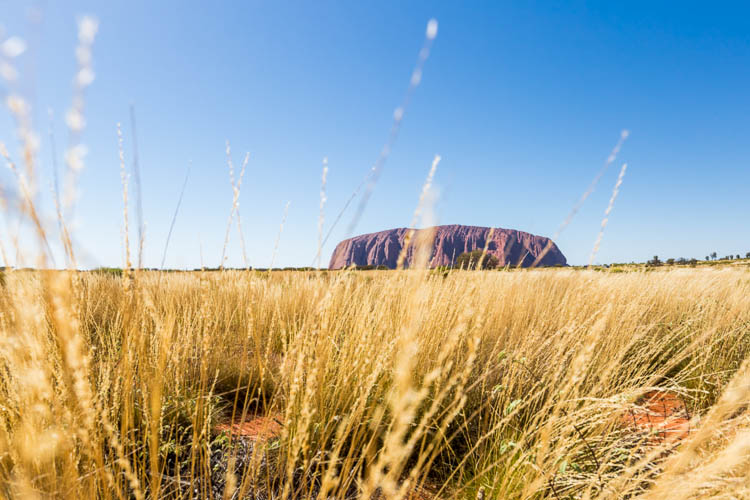
Uluru through the desert grass
I travelled to Uluru as a guest of Voyages and stayed at Sails in the Desert Hotel – part of Ayers Rock Resort. I flew with Jetstar Airways, who fly direct to Uluru (Ayers Rock) from Sydney daily, from Melbourne five times a week and starting 3 Aug, from Brisbane three times a week.
Images Copyright Andrew Watson 2018, with thanks to Josh Bender (@travelwithbender) for courteously sharing the food pics indicated.


















